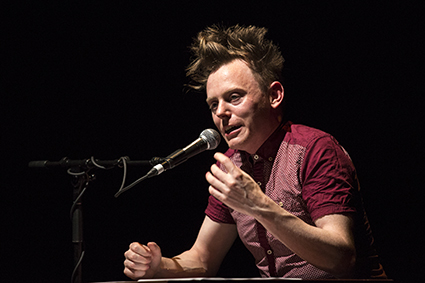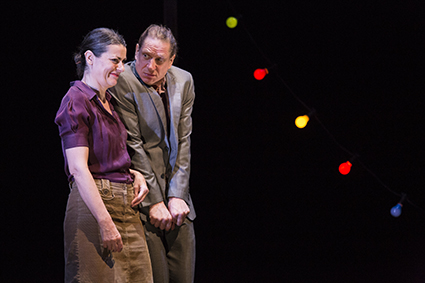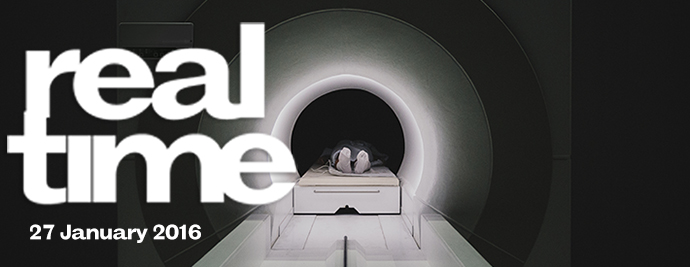 |
Christopher Brett Bailey, This is How We Die, Sydney Festival photo Jamie Williams |
This is how we die
We sit in front of Canadian Bailey's public radio facility—desk, microphone and a stack of notes. Without warning, he accelerates into a multitude of millennial think-piece sound-bites on hipster identity—“it’s the other white people you cross the street to avoid”—his vocal range stretching from pop-yodel to George Thorogood growl.
When he does catch his breath, his protagonist-self in a budding youth romance, he takes us on a road trip into Tarantino's America, describing encounters of cartoonish violence. The first of two decapitations we are asked to picture is of his girlfriend’s swastika-shaped father (after an accident he insisted the surgeon shape him thus) whose head is mutilated by a car with an anti-fascist bumper sticker that crashes through his house and is driven, to wry effect, by a latter-day Thelma and Louise.
As Bailey attempts to control his unreliable narrator-self he finds verbal zen only when he steps aside from his persona’s wildly indulgent fantasising, landing on and repeating a single utterance, ‘jism’, again and again, at first playing it for smutty laughs and then slipping into a delicate exercise of semantic satiation, a mantra that empties the word of meaning.
The final movement of this monologue points to Bailey's broader intent when he bows out of his surrealist tornado-chasing odyssey into the darkness. This ending was hinted at the beginning when audience members were supplied with earplugs. An electric quartet (two violinists, bassist and Bailey on guitar) overwhelms us with a hypnotic, overpowering rock coda that seems fitting in the wake of David Bowie's recent passing. (Quite appropriately, Ziggy Stardust is referenced in one of the protagonist's encounters involving an iPod, a gas station and a violent and subsequently decapitated priest). I opt not to use the earplugs provided and oblige the bass-and-string heavy light show (car headlights blinding us) to bring me to a symphorophiliac (vehicular disaster sexual fetishist) climax and guide me out of this Homeric near-death experience.
 |
Cathy Naden, Jerry Killick, Forced Entertainment, Tomorrow’s Parties, Sydney Festival photo Jamie Williams |
Tomorrow’s Parties
Forced Entertainment’s Tomorrow's Parties is less fast cars and hard liquor rock and more like a backyard tea party hosted by the William S Burroughs Appreciation Society. Colourful festoon lights suggest a suburban outdoor setting which springs to life without much introductory fanfare. Cathy Naden and Jerry Killick perch on a wooden palette and quietly commence an 80-minute speculative marathon. Instead of a meat raffle, they each offer up well-worn arguments on what the future might hold. Many centre on how to solve or embrace the population crisis. A great number of their predictions invest in cyborgian fetishism and other technologically-aided fantasies. Medieval nostalgia is introduced as we yearn for simpler times. Vegetarianism and cannibalism are placed on two ends of the same dietary spectrum.
A moment which plunges the audience into deep silence occurs when Killick prises apart the taboo of socially acceptable suicide. A jaw-dropping piece of Sophist ‘choreography,’ it is handled with such charm and frightening logic, that it’s hard to imagine another performer making it their own.
As a double act, Naden and Killick take on playful oppositional stances (light versus heavy, humanistic versus misanthropic, compassionate versus punitive, utopic versus dystopic, laissez faire versus over-regulation). But they morph quickly into two well-meaning if loquacious party guests who dominate the proceedings and lightly reveal their prejudices. Polite sociological musings are lightly written off with counter-musings, transforming each proposition into a another depressing historical platitude.
Premise-wise, Tomorrow's Parties stretches beyond the creative writing workshop provocation "Complete this sentence: ‘In the future,...’” Everything that was offered we may have thought of before but perhaps been fearful of taking to its logical conclusion.
While Christopher Brett Bailey put all his anxieties on display, the writing here simply invites us to tango with each of our own fears. As yet another Forced Entertainment list-driven durational work, Tomorrow’s Parties is a disarmingly simple presentation, and a deeply humanising one. I might even try the exercise at my next family gathering—it could result in vibrant political discussion but with much less antagonism.
Sydney Festival, About an Hour: This Is How We Die, writer, performer Christopher Brett Bailey, dramaturg Anne Reiger, sound design George Percy; Forced Entertainment, Tomorrow’s Parties, director Tim Etchells, design Richard Lowdon, lighting Francis Stevenson; Carriageworks, Sydney, 20-24 Jan
© Teik-Kim Pok; for permission to reproduce apply to [email protected]








 back
back